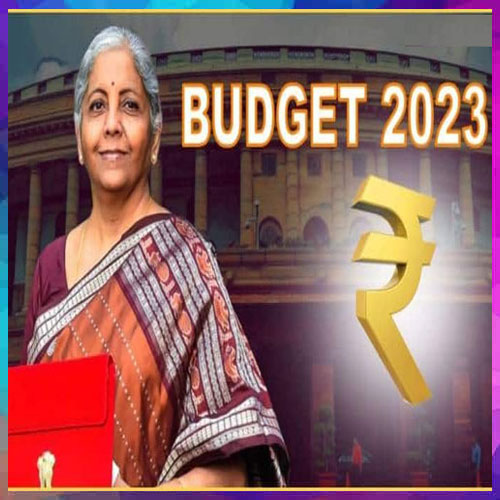Budget Expectations 2023-24 of IT industry
2023-01-30
On February 1, Finance Minister Nirmala Sitharaman will present the Union Budget 2023-2024 in the Parliament. It will be Sitharaman’s fifth budget speech and it is the last full budget before the General Election 2024. Most experts believe Budget 2023 will take a balanced approach towards fiscal consolidation and economic growth while focusing more on capital expenditure on infrastructure (including defence, railway, roads, etc.), widening production-linked incentive schemes for more sectors, boosting rural demand and divestment targets.
The IT industry is considered to be the backbone of the Indian economy. It is the most flourishing industry in the country boosted with government initiatives like Digital India, Make in India, PLI schemes etc. So let’s take a look at the expectations of the IT companies in the country.
Alok Dubey, Chief Finance Officer, Acer India
“Budget 2023-24 would probably be the most challenging one that Finance Minister Nirmala Sitharaman would be tabling on February 1, 2023. I think that this year's budget should give digital infrastructure and skills a high priority. Although India may have a positive view of "digital" and technology, more needs to be done to support the country's digital-first strategy as it aspires to become a USD 5 trillion economy. The government's commitment to digital skill development and its alignment with the IT Tech sector, and the PLI scheme targeted at helping manufacturers of IT hardware and computer servers need to receive equal weight in this year's budget. Government policy could be changed to promote the development of talent and skills. The tech industry requires a talented and skilled workforce. The government may provide funding for programmes to modernise educational buildings with state-of-the-art R&D capabilities.”
Sunil Sharma, Managing Director - Sales, Sophos India and SAARC
“Cyberattacks are increasing in terms of scale and complexity, making it one of the biggest threats enterprises face today. Amidst this, there is an urgent need to build a talent pool that is equipped to handle new-age sophisticated attacks. It would be welcome if the Union Budget places a focus on bridging the cybersecurity skills gap and increasing awareness around the same. We are hopeful that the government will take cognizance of this, and increase spending on skilling and training initiatives. In the long run, this will help create employment opportunities, as well as build defenses against threat attackers.”
Puneet Gupta, Vice President & Managing Director, NetApp India/SAARC
“Despite recent global headwinds, we have seen consistent growth in the technology sector. With the rapid technology adoption across sectors, we are well poised to becoming a USD 5 trillion economy soon. With cloud and data technologies becoming the de-facto standard for businesses to operate, Gartner estimates that public cloud spending in India will grow 27% YoY in 2023. Amidst this, there is a need for the government to focus on incentivising the use of cloud services and deep tech like AI, blockchain etc., across industries.
In 2023 and beyond, upskilling of talent in an environment driven by technology will be mission critical. The government has made great strides towards this, through the Skill India program. In this year's Union Budget, it would be good to see more investments and programs in upskilling, as this is an important factor towards achieving the collective Digital India dream of our nation.”
Hemant Tiwari, Managing Director, India, Hitachi Vantara
“The Indian economy is amongst the best performing economies in the world, we see huge potential for the technology sector in India to exhibit continuous growth. This is an opportunity for the government to incentivize the adoption of Artificial Intelligence (AI) and Cloud Computing across industries which will aid technological development at scale along with providing increased employment opportunities.
According to Mordor Intelligence, the Indian data center market is expected to grow at a CAGR of 8% over the period 2021 to 2026. A revived focus on the Make in India and Digital India movements will accelerate the investments towards data centers in India. In the Union Budget 2023, we expect to see strong steps being taken to boost the digitalisation of infrastructure in industries such as the BFSI and manufacturing sectors.
Apart from economic and technological growth, sustainability is critical to the country’s long-term development. The Budget should create a roadmap for the country’s greener future. Automated solutions and data-driven processes will play a prime role in achieving sustainability goals. Hitachi Vantara offers digital solutions, eco-friendly data infrastructure and sustainable smart city solutions to reduce carbon footprint.”
Rajiv Srivastava, MD, Redington
“In the upcoming Union Budget 2023, we look forward to policy initiatives which will accelerate our journey to a $10 T economy in the near term. Economic growth is now increasingly driven by digital transformation and therefore investment initiatives that lead to the build-out of a quality digital infrastructure – data centres and high-speed internet – will be crucial.
India is a global leader in technology services and we expect incentives for investments in new innovative technologies like Artificial Intelligence, Blockchain, Metaverse, 5G, Internet of Things, and Data Sciences to ensure we maintain our leadership. We have to encourage people to participate in the digital economy and towards this, the budget should also address the need for talent and skilling in digital technologies. This has the potential of creating a range of sustainable jobs.
We must aspire to become the global hub for innovation and our capabilities in technology can make that possible. The budget should provide an incentive structure for creating intellectual property in the country. Sectors like Healthcare, Green Energy, Retail, Fintech, Research and Development and others can benefit immensely, help improve the quality of life for all citizens and make us a real powerhouse.”
Tejas Goenka, Managing Director, Tally Solutions
“With majority of the pandemic restrictions lifted and life getting back to normal, all eyes are the forthcoming union budget. Various sectors have high hopes from the budget to an extent that certain frameworks and inclusions will help them in recovering from the impact of the pandemic. Below mentioned sectors are the ones that should be given a considerable importance in the upcoming budget.
MSMEs
MSMEs have and will continue to be an important driver of the growth of our economy, playing an important role in the “Atmanirbhar Bharat” initiative. The budget must focus on improving accessibility to funding, encouraging adoption of digital payments and incentivizing investments in the MSME sector. The main challenge for this sector continues to be accessibility to funding at a reasonable cost as the sector continues to be significantly dependent on informal sources where the interest rates are exorbitant. The Government’s emphasis should be to bring the MSME sector into the formal lending process. On the backdrop of the steady increase in interest rates, an interest subvention scheme would be encouraging for MSMEs. It is also recommended that the threshold for collateral free loans be increased to from Rs 1 Crore to Rs 2 Crores. The act of incentivizing the investments that go into the MSME sector will further drive more investment towards these businesses. Together with schemes focused on employment generation the budget must provide support in the form of grants for skill development. To promote a system of greater trust and ease operations for MSMEs, compliances should be liberalized and simplified.
Software Product Industry
The Indian software industry has proven its ability to grow, transform and remain resilient even during challenging times. The sectors agility has enabled companies globally to work pretty much seamlessly during the pandemic and recover quickly. The pandemic created an irreversible shift where digital technologies have become an imperative across organizations and governments globally. This represents a unique opportunity for India to further accelerate growth and become the digital talent hub for the world.
In support of this, the Government should consider increasing the threshold of total emoluments for additional employees from Rs 25,000 to Rs 40,000 under Section 80JJAA. This will provide practical significance as majority of entry-level employees in software companies are being hired for monthly emoluments more than the threshold.
Previously an additional deduction was available under income tax for research and development spends but this was subsequently removed. The government should consider either re-introduction of additional deduction under income tax or to provide subsidies to software companies for encouraging new research and development activities. In addition, since software products are treated as goods, it is recommended that withholding tax rates are kept on par with sale of physical goods i.e., 0.1% to avoid blockage of working capital in the form of TDS and for overall development of the industry.
The big dilemma that still exists in the industry about using HSN or SAC code for software products must be addressed as most software products are being delivered virtually. It is imperative that the Government brings in clarity for software products delivered through various forms of virtual delivery.”
Sonit Jain, CEO - GajShield Infotech
“Government is committed to deregulating the economy and ushering in systemic reforms. It has preempted the need for Information Technology and is committed to augmenting inclusive growth across all sectors. Our PM's vision of India can usher in an era of increasing digitization with Web 3.0, Artificial Intelligence, and regular Tech Disruptions. Indian Computer Emergency Response Team (CERT-In), which functions as the federal agency to address the country’s cyber security, has led to diminishing momentum of cyber-attacks on government infrastructure. This year, we look forward to government creating a policy framework for companies in India to implement data security and build a strong eco-system to fuel digital growth in India. We also hope to see budget allocation towards Cyber Security training to help build the required skills in people which will help to protect our digital infrastructure and defend our country against cyber-attacks.”
Rajendra Chitale, CFO, Crayon Software Experts India
“The tech industry worldwide has seen many ups and downs in 2022 with a recession looming over the industry. Thankfully, India’s tech industry has not been significantly impacted by what is happening overseas. So right now, all the eyes are set on the upcoming Union Budget 2023-24 to be presented by Union Finance Minister Nirmala Sitharaman. We, on behalf of the tech industry, have our own expectations from this year’s budget. The growth of the IT and ITeS industry in India has been stupendous and we are happy with the Union government’s push in ensuring that the country is taking the digital leap. It is because of such a leap that since 2016, the number of startups in India has grown 90 times. From increased adoption of digital services and surging demand in new-age technologies like AI to the launch of 5G services, the Indian tech sector has been riding the wave.
I believe that currently, the tech industry’s #1 struggle is a lack of skilled workforce, especially with emerging technologies. The government needs to focus on skill development at the school and university levels so that the new batch of students joining the workforce can be prepared and updated to the technologies and standards of the industry. While the government is focusing on empowering the country with digitalization it should also look into the security measures. The recent demonstration of a cyberattack against AIIMS Delhi and its struggle to come out of it is one example of where the cybersecurity measures stand, as we make digital progress. Therefore, the government should, in the budget not just announce schemes, policies and set aside an amount for digital development, but also for cybercrimes. The digital infrastructure, especially with 5G being made available for Enterprises and individuals in certain tier 1 cities is receiving the attention of everyone. But there is an utmost need to improve and even standardize the digital infrastructure that will help SMEs/SMBs. The infrastructure should now just be limited to tier 1 cities but must be expanded to tier 2 and tier 3 cities where there is a majority of the workforce available. These are currently the pain points that need to be addressed in the budget which will boost India’s tech vertical and those depending on it positively.”
Prashanth GJ, CEO at TechnoBind Solutions
“The Union Budget presentation is the most anticipated activity to take place right before the end of the financial year. The tech vertical has been thriving in India, especially over the last three years. Digital transformation has been taking place at warp speed due to the circumstances that cropped up post-pandemic. We are looking forward to this year’s Union Budget being presented by Union Finance Minister Mrs Niramala Sitharaman on February 1, 2023. The government aims of achieving a $5 trillion GDP by 2025 considering that India is one of the world’s fastest-growing economies and I believe that the Indian tech sector will be a valuable contributor to this growth momentum. There are, naturally, expectations by the tech industry too from the budget.
There is a dire need for the government to form the right industry-friendly policies concerning data sharing, privacy and security. Fighting cybercriminals and formulating the right law against them is of dire need today as there is a looming threat against data privacy and security. Apart from policies, there needs to be expertise and think tanks set up and funds dedicated for the training of the staff in every major government department from the union to the states, to strengthen the cyber cells. The 5G will advance technology by multifold and its tools by multifold, but unfortunately, our infrastructure is not capable of handling a full-fledged advancement including tier-1 cities. The government needs to ensure that the budget needs are set aside and estimated deadlines need to be set to ensure that the overall infrastructure matches the current tech advancement and the future. But a better focus needs to be given to ensure that Tier 2 & 3 cities, towns and even rural areas have better infrastructure that will support the tech advancement and help them match the growth as that of a Tier 1 city. Smart city projects need to be finished and newer cities need to be added to the list that will help us revolutionize the tech industry and the associated verticals. Hopefully, this budget will help us formulate and reach a new milestone.”
Kuldeep Malhotra, Dy. Managing Director, Konica Minolta Business Solutions India
“The union government is continuously working and finding solutions to achieve its 2070 sustainability target. Keeping the same in view, we hope that in the upcoming budget, the government will introduce better and more attractive incentives, aimed at promoting the green economy. Besides this, we expect that government interventions and policy changes like tax rebates for meeting set environmental standards, certifications, green taxes on harmful environmental activities, and subsidies on the use of green products can go a long way in furthering the agenda of sustainability.”
Sudhindra Holla, Director, Axis Communications, India and SAARC
“From increased adoption of digital services and surging demand in new-age technologies like AI, analytics, to the launch of 5G services, the Indian tech sector has been readily serving the tech evolution. With the budget just around the corner, the government must empower the enhancement and innovation capabilities of the nation with increased allocation to research and development ecosystem. Additionally, digital public infrastructure investments need to be amplified for the success of smart cities in India. With the current impetus on expanding the railway and roadways, more concentration must be relied on next-gen surveillance to not only monitor the traffic violations but to also ensure public safety and gather real-time actionable insights during exigencies. With the nation coming back to the “new normal” post COVID, safety of child and women, and surveillance must be a high priority. The growing need for security and surveillance is a driving force for the connected digital world and hence clearer representation of Make in India policy and framework can substantially aid our growth and development. India’s digital economy is still evolving and to achieve its true potential, customs duty and tax relaxations will be a welcome move amid the global economic downturn.”
S Durgaprasad, Co-Founder, Director and Group CEO, Bahwan CyberTek Group
"India in 2023 brings back memories of India in the 1990s. In the past, liberalization increased opportunities for job and wealth creation. Today, there is palpable optimism among investors and entrepreneurs. India’s digital edge, coupled with our knowledge capital, is powering a shift capable of positioning the country as a powerhouse of globalization.
We have quickly and effectively dealt with exogenous threats, welcomed change, and embraced technology. Not just at the legislative or executive levels but all the way down to the local level with least literacy, as seen by the extensive use of digital payments and digital. Technology will continue to drive investments and speed up economic progress despite the impending concerns of inflation, geopolitics, and supply chain problems. Here are some of my expectations from the budget:
Incentivize the pivot from services to products:
Today, India is uniquely positioned with the right mix of talent, infrastructure, and the most powerful enabler – confidence, to become a global technology hub. Last year, Indian IT crossed $200bn in total revenue and 5mn in workforce, and the IT industry accounted for 7.4% of India’s GDP in FY22.
Indian enterprises have excelled at providing managed services, consulting, and outsourcing services and are now looking at building global products with local talent and ecosystems. We are at a crucial point where the emergence of AI, ML, and IoT is in tandem with the growing technology talent pool, driving innovation and entrepreneurship. This intent to build must be encouraged with policies that incentivize R&D. The government must emphasize improving the overall share of gross expenditure on R&D (GERD) as a percentage of GDP, which is currently at about 0.7% to about 1.3 - 1.5%
Catalyze collaboration for upskilling:
Post-pandemic digital enterprises demand niche practical skills and experience that academia is simply not equipped to provide. The government should strengthen the link between academia and the industry, and initiate collaborations to address this knowledge gap with enterprise-specific curriculum.
Programs like FutureSkills PRIME and Responsible AI for Youth conceptualized by the Ministry of Electronics & IT, GoI are a welcome move. But to keep up with the pace of rapid technological advancements, and the growing relevance of AI in everyday applications, the government must prioritize funding for upskilling. Together, with a strong network of multiple stakeholders we will be able to analyze the evolving job landscape and forecast skills demand.
Relax Special Economic Zone (SEZ) rules:
SEZs have played a crucial role in India’s tech growth story. These growth engines accelerate economic growth, promote exports, encourage investments, and most importantly, create jobs. According to the Ministry of Commerce and Industry, SEZ exports increased to INR7595.24 billion in 2020-21. Further, investment in SEZs increased from INR40.355 billion in 2005-06 to INR6174.99 billion by 2020-21.
To increase global competitive advantage, our SEZs which enhance ease of doing business and have proven to do so should be complemented with policies that attract investment. GoI must look at policies that regulate WFH rules, increase incentives for enterprises in SEZs, and procedural relaxations to improve operational and exit issues.”
Harshil Doshi, Country Director, Securonix
"2022 was a tough year for India with high profile cyber-attacks, especially on government agencies. The recent AIIMS ransomware attack sent shockwaves across the country and made everyone realise that having a traditional cyber security strategy will just not work anymore. I hope the Union Budget makes significant allocations to innovation and skill development. With the attacks getting sophisticated, we need AI/ML backed technologies that can preempt and prevent frauds. At the same time, the public needs to be sensitised about the various social engineering techniques that attackers use. Appropriate training programs and workshops can avoid such instances. It is not surprising to know that some of the data breaches that SMEs or common people suffer don’t even make it to the public domain. If only basic cybersecurity hygiene is followed, we can protect our systems in a better way. In short, India’s techade needs an innovative & modern cyber security strategy to flourish."
Maheswaran Shamugasundaram, Country Manager - India, Varonis
"As the Digital India mission is on fast track, cybersecurity has become critical. We need a robust cyber security policy to protect the most prized asset, which is data. As the work and the geopolitical environment is quickly changing, the attack surface has increased enormously with sophisticated cyber-attacks. Therefore, the government must increase spending on creating an atmosphere of trust, online safety and accountability. We have to develop a sound ecosystem for the future of work and skill development in order to strengthen our position globally. This also augurs well with the G20 mission of facilitating technological transformation & digital public infrastructure. Such novel goals require significant investments on preemptive technologies and cyber awareness programs. Lastly, from a reform perspective, we are looking forward to an effective & gradual implementation of the newly drafted data protection bill, giving ample time to businesses to make necessary changes."
Ashok Rajpal, Managing Director, Ambrane
"The central theme of Budget 2023 will be to boost Indian manufacturing. Increasing manufacturing is the best way for the country to attract investment and increase its forex reserves. To encourage manufacturing, aka. Make in India; the government must provide subsidies and fiscal stimulus to the private sector. The reduction of corporate taxes and implementation of various PLI programs have boosted domestic manufacturing; however, the industry now needs a boost with additional Make in India plans and incentives for electronics manufacturers. PLI initiatives will be expanded to attract more private investment and participation in the industry. For indigenous production to continue perpetually, self-reliance on the required state-of-the-art technologies must be a key focus area. Being self-sufficient would imply manufacturing complete platforms, expanding in-house R&D capabilities, and so on. Increased budgetary allocations for R&D are required. Furthermore, some weighted deductions on R&D expenditure and tax breaks for industry players may prove to be drivers of the Indian manufacturing ecosystem. The industrial sector requires tax breaks and simplified legal procedures. Unnecessary legislation should be phased out, and compliance should be simplified. This will boost trust and confidence between the private and public sectors."
Swapnil Jambhale, Co-founder, SafexPay
“There have been significant developments pertaining to digital payments in the last one year. Most of these initiatives were announced in the last year’s budget, including the introduction of Central Bank Digital Currency (CBDC) and promotion of Unified Payments Interface (UPI). While the much-needed impetus to financial innovations is in process, it is crucial to strengthen the penetration of digital payments infrastructure, especially in the semi-urban and rural parts of the country. Therefore, we would expect the Government to allot funds in the Union Budget 2023-24 towards setting up of digital infrastructures focused on building citizen centric facilities and address various issues pertaining to digital payments. These could include MDR compensations for large ticket transactions, digitisation of Central and State related citizens’ services such as 7/12 extract, birth certificate, property/water tax and others.
We would recommend tax incentives that would effectively pass on to the end consumer to encourage them to contribute towards automation and digitisation. In the current GST framework, fintech companies usually suffer a loss of input credit. With the Government ensuring that the input credit is fully provided for, revenue leakages can be avoided and eventually the benefits can be passed on to the end (retail) consumer.
In December 2021, the Union Cabinet had cleared INR 1,300-cr incentive scheme to promote digital payments digital transactions using UPI and RuPay debit cards. A similar incentive scheme may be extended to RuPay credit cards in the upcoming Budget. This will encourage greater adoption of RuPay credit cards in the country. Awareness campaigns by the Government and the industry are the key pillars for encouraging digital payment initiatives in the country. While the Government has been consistently allocating funds for promotion of cashless payments in the last 2-3 years, it can be expected that a marginal share of 5–10% of the Government’s expenditure on promotional measures may be allocated for awareness campaigns.”
Sanjeev Chhabra, MD & CEO, Beetel Teletech
"Investment in infrastructure is crucial for the growth and advancement of any sector, and we are grateful for the government's efforts in supporting the telecom industry. Last year, the government recognized the importance of reliable and sustainable power sources by allocating an additional 19,500 crores for the solar PLI scheme. However, with the rollout of 5G networks, the trend of solarizing telecom towers is gaining momentum. We hope that the budget for 2023 will continue to prioritize the needs of the telecom industry and provide the necessary support and incentives for developing telecommunications infrastructure in India.
At Beetel we are dedicated to doing our part to make a change and work towards a sustainable future. With one of our partners, we have already started the rollout of solarisation of existing towers for a Telecom Service Provider, wherein Solar solutions are being installed at sites. Going forward we would also be offering an end-to-end, comprehensive solution, wherein Solution Design, Installation and Commissioning, solarisation, integrated software-based management, and reporting of the health of the infra and energy analytics along with operations and maintenance would be provided.”
Ramanujam Komanduri, Country Manager, Pure Storage India
"2022 was a difficult yet extraordinary year in many ways. Digital has taken center stage as the effects of the pandemic continue to recede. India is already one of the fastest growing digital economies, and we will continue to strive towards becoming the global digital capability hub. The budget should focus on three pertinent aspects. Firstly, hasten infrastructure expenditures in digital technologies, since technological investments are thought to have a multiplier effect on the economy. Secondly, increase spending on R&D to foster innovation and tap into the amazing engineering talent that we have in the country. Finally, enhance the focus on sustainability as climate change requires urgent attention and action and requires all of us, as individuals, organizations, and the government to pull together, utilizing environmentally sustainable technology.”
Gautam Nimmagadda, Founder & CEO, Quixy
“The past union budget focused copiously on amplifying the digital ecosystem in the country. But to explore a comprehensive digital India, the private and government sectors must be incentivized to adopt indigenous digital solutions developed particularly in the MSME sector. Currently, startups can avail of a tax holiday for 3 years since incorporation. However, the ideal exemption should be 10 years, in view of the high cost of solution development. As positive employment drivers, startups also require government intervention in the expensive affair of hiring and retaining the right talent to drive growth.
Furthermore, despite having several means of financial backing like PMRY, Credit Guarantee Fund for MSMEs, Start-up India, etc., MSMEs face tremendous challenges in gaining the right window of financial support. This discourages them from becoming an intrinsic part of the Digital India program. Hence, to lead the startups onwards and upwards, a single-window process to enable the right financial support from government would be incentivizing for MSMEs. This will catalyze and leverage the full inherent potential of the Indian technology industry to become champions of digitization”.
Ketan Patel, Chairman & Managing Director- Creative Newtec
“As we are gearing up for the announcement of this Union Budget 2023, there is a multitude of expectations from the government. The budget is likely to be growth- oriented with a focus on certain industries manufacturing being one of them under the Make in India initiative, we firmly believe that government should consider the inclusion of some more categories such as Consumer Electronics Space which will give the required boost to the industries operating in the fast-moving electronics good. Also, as taxpayers, we believe the GST on electronic goods should be rationalized as well the refund process should be eased.
There is an urgent need to revamp and enhance the skill sets development that will open employment opportunities.”
Akash Sinha, Co-founder & CEO, Cashfree Payments
“The recent regulations laid by the RBI for the Indian fintech ecosystem has made India one of the most favourable markets for fintech organisations across the globe. The upcoming Union Budget holds high importance, as the Indian fintech ecosystem is at the cusp of expansion, both within the country and internationally. It is encouraging to see that the government, as demonstrated by a number of recent initiatives, recognises the reach of fintech to the underserved and unserved regions of the nation. These government sanctioned fintech innovations are further driving increased financial inclusion across the country. Therefore, it is crucial that the growth momentum of fintech continues in 2023 as well.
· Deepen the usage of offline digital payments:
More offline digital payments products, such as UPI 123 and UPI Lite, should be introduced to aid digital penetration in semi-urban and rural regions of India. Offline digital products offer tremendous relief to consumers in these areas who face traditional barriers to entry, such as lack of reliable infrastructure and slower devices.
· Accelerate the growth of cross border payments:
The upcoming budget should also focus on increasing the acceptance of homegrown payment solutions in more geographies, increasing cross border transactions. More initiatives, such as allowing Non-Resident Indians (NRIs) to directly make bill payments using Bharat Bill Pay System (BBPS), will act as a growth catalyst for cross border payments, when introduced.
· Encourage skill development and capacity building:
The budget should include incentives/policies that encourage skill development and capacity building across sectors. In particular, skill development in technology and digital finance will help small entrepreneurs avail the benefits of innovative financial products offered by fintechs. This will boost mutual growth for both sectors. The promotion of fintech clusters, such as the Karnataka government’s Beyond Bengaluru initiative, have significant potential to provide crucial employment opportunities, thereby boosting fintech’s contribution to the country’s tech industry. Establishing fintech clusters in smaller cities and towns is vital to achieving widespread development and inclusivity.
· Enable greater digitisation in tier 2 and tier 3 cities through newer technologies like 5G
With one of the world’s highest number of mobile internet subscribers, India has the potential to harness the power of 5G to support seamless hyperconnectivity. 5G will not only drive greater mobile and internet penetration across the country, but will also play a crucial role in further boosting digital payments in India. This will lead to greater financial inclusion as more fintech innovations can be developed to reach the unserved and underserved sections of society.
· Boost MSMEs through promoting adoption of digital infrastructure
While India’s MSME sector is enormous and plays a significant role in the country's GDP, a hurdle to this sector’s long term development is the inability to embrace the right technology solutions. Generating the right kind of awareness about the benefits of digital infrastructure and the availability of the payments ecosystem would be beneficial to the country’s 6.3 crore Micro, Small and Medium Enterprises (MSMEs). Access to digital banking, lending, collections, and other fintech products can transform the MSME sector, providing additional crucial employment opportunities and boost this sector's contribution to India’s GDP.
The digital payments sector expects that this year’s Union Budget will focus on further building the relationship between businesses, industries, the fintech ecosystem and other important pillars of the Indian economy.”
Sarvagya Mishra, Co-founder & Director of SuperBot (PinnacleWorks)
“Over years, the popularity of Artificial Intelligence (Al) has skyrocketed across industry sectors as a result of the greater push toward automation. While previous budgets acknowledged the relevance of AI technology in modernising India, we now expect prospects and large government initiatives from budget 2023 which can position India as one of the world’s favoured Al leaders. Since we have an AI-powered voice-based product, we are also anticipating announcements and measures to improve digital infrastructure such as high-speed internet and data centres. Moreover, as the founder of the startup, I eagerly look forward to funding and investment opportunities such as venture capital and angel funding to accelerate our business momentum.”
Kushang, Co-founder & CEO of SupplyNote
“As a technology start-up in the food and beverage industry, SupplyNote is keenly aware of the challenges facing the sector. From high taxes to complex liquor regulations and difficulties in obtaining permits and licenses, the industry is in dire need of a more streamlined and business-friendly environment. We hope that the Budget 2023 will address these issues by simplifying the tax bracket and easing regulations around liquor, permits and licenses. Additionally, as the food and beverage industry is one of the largest job creators in the country, we look forward to the government creating a positive environment for the sector, including relaxation on taxes for start-ups and the positive induction of private companies in the government ecosystem. We also hope to see the impactful implementation of ONDC, as it will help to digitize and optimize the backend operations of food businesses and increase profitability.”
Animesh Samuel, Co-founder & CEO, E42
“While the former two budgets kept the focus on technology for creating a better India, this time's budget is anticipated to be conducive to situating India as a leader in the AI space across the world. Building new technologies and services, taking a more proactive approach to digital transformation, automating more processes, and employing AI and machine learning that can adapt to the changing demands of businesses are some of the areas where we see the scope for massive advancement in this space. We, at E42, are eager to see what the budget has in store for AI and the policies that will propel India's technology-led economy!”
Bhaskar Mishra, Head of Product, Mihup
“This year is going to be very crucial for the government’s efforts to boost digitization in India, in the tech and startup industry, especially the AI solution providers, have pinned a lot of hopes on the upcoming Union Budget. The policy decisions and budgetary allocations that the government would make are expected to shape the future of India's thriving startup ecosystem. Given the fact that the country is at the cusp of a technological revolution, it is imperative that the government supports and empowers startups in this domain to thrive and innovate for a better future. The AI and startup sectors are in anticipation of steps like increasing the angel investor pool at the seed stage and a tax relief incentive of 30% of the cost of equity shares set off against the investor’s income tax liability for the year in which the investment was made. In many cases, employees tend to use
ESOPs to accumulate wealth and use the same to launch their own startups. That’s why the startup sector has been demanding that the ESOPs should be taxed at the time of sale, and not at the time of vesting. Another critical need is to establish a single window for all registrations including company incorporation, shop establishment, GST registration, MSME certificate, etc. This is going to simplify things and save startups crucial time, money, and effort. Also, there has been a lot of buzz about the creation of new industries and startups in the domains of Robotics, SAAS, Deep Tech, Clean Energy, Fintech, and Digital Health for the year. We hope to see the upcoming budget address all these aspects for the country to move ahead toward the vision of achieving a GDP of $5 trillion by 2024/25.”
Abhijit Bhattacharya, Founder & CBO, OneGreen
“There have been several steps taken by the government in the last few years to benefit the economy as well as the startup ecosystem such as digitization, innovation support, ease of doing business, FDI policies, and funding support. The Make In India initiative has also led to the emergence of several home-grown startups that are creating solutions to bring about sustainable change in lifestyles. With the world staring at several challenges, we hope that the government will introduce policies, initiatives, guidelines, and financial steps that will not just create more economic output, but also benefit the overall life quality and productivity of the 1.4 billion Indians. Concerns about the higher cost of plant-based organic foods and lack of awareness about nutritional options, have to be eliminated through sustained information sharing and support for companies manufacturing green nutrition products. There is also a need to develop smart technologies that help in increasing the output of agriculture without adding a carbon footprint or bringing more forest land under farming coverage.
Apart from this, companies that manufacture such products, and e-commerce platforms retailing sustainable food and other eco-friendly lifestyle products should be provided benefits like tax incentives, lowering of GST on green products, and reduction of customs duty on import of green food products and ingredients. GST benefits to startups manufacturing such products would encourage more companies to enter the segment. It is also imperative to support tech-driven agricultural practices focusing on such ‘Made for India’ foods, and farm-to-table startups in India. The Government of India has been revolutionizing the manufacturing sector and startup economy through its efforts. By providing budgetary allocations that lead to the continuation of existing schemes and expanding the horizon through new initiatives and tax benefits etc, it is possible to not only unlock greater economic output from the startups but also boost sustainable development in the country!”
Mandar Agashe, Founder MD & VC of Sarvatra Technologies
“There have been several incentive schemes announced by the Government in the last few Budgets which has helped promote digital payments, especially the Unified Payments Interface (UPI) based payments. This in line with the Government’s ‘Digital India’ initiative aimed at financial inclusion. We are expecting the momentum to continue in the upcoming Budget. Serving the unserved and underserved is the mission that should continue with UPI 2.0’s recent products, such as UPI 123 and UPI Lite, the two most crucial products that will help penetrate the semi-urban and rural regions of India because of easy accessibility it offers to those who can't afford smartphones but are using feature phones and want to transact digitally. At gram panchayat level or at the village level, Self-Help Groups (SHGs) can also promote the usage of offline payments through UPI. This will help the UPI to grow really fast. When SHGs start using the offline mode of payment through UPI, the confidence of the general public will start building up. If such SHGs are provided with incentives for doing digital payments, that will be a huge game changer for the last-mile village.
The Government may consider enhancing the payments acceptance infrastructure in the underserved regions of the country. This can be done by providing an impetus to Aadhaar Enabled Payment System (AePS) terminals, which will take payments to pockets where customers may not have a smart phone and debit cards as yet.
The upcoming Budget should also focus on expanding digital payments footprint across the world. We laud the recent initiative of NPCI to extend UPI payment facility to NRIs using their international mobile numbers. Currently, NRIs residing in 10 countries, including Singapore, Australia, Canada and the United Kingdom, will be able to avail this facility. We are hopeful that by the end of this year, almost all countries with good NRI populations will join UPI. The Union Budget 2023-24 can accelerate the pace of UPI going global as well as making it interoperable with global payment networks. Initiatives to take BBPS platform to other nations may also be considered.”
Puneet Maheshwari, Director, Upstox.
“A prime focus of the 2023 budget may be to act on the several lessons and learnings that the previous year brought with it. Our industry is extremely dynamic and subject to the impact of a number of extrinsic factors.
Just like our country’s vision of Make-In-India, from a broker's perspective, the budget should also focus on Trade-In-India. The government should consider regulations that make trading and investing in India a seamless and rewarding journey. From a trader/investor perspective, it will be beneficial to remove LTCG on equities, which is currently at 10% if the capital gain is more than ₹ 1 lakh in a financial year. It would also be ideal to introduce tax exemption on STCG up to ₹1 Lakh.
In order to put more money in the hands of our people, the Government should also consider eliminating the tax on dividend payouts, lowering the tax bracket for investors, and increasing the basic tax exemption level from 2.5 lakhs to 5 lakhs or higher. More cash in the hands of the people will mean more money to invest.
For the overall fintech industry too, which is growing rapidly, there needs to be a mandate to regulate and simplify taxation, like on ESOPs, and provision of incentives for adopting AI(Artificial Intelligence) and ML(Machine Learning). Further, software products attract a GST of 18%. A reduction in GST will promote development of indigenous technologies by fintech players. Creation of fintech innovation funds will be another avenue to incentivise start-ups.
Broadly, the budget should not only be concerned with improving the country's economy, but also take a comprehensive approach to enhancing economic conditions for every citizen. We expect this budget to favour the needs of industries across India’s economic spectrum, and look forward to seeing how it unfolds.”
Vidit Aatrey, Founder & CEO –Meesho
"Budget 2023 gives our visionary government an opportunity to put our MSMEs in the fast lane, building on its proactive efforts to transform the small business economy. First, the government can bolster working capital for e-commerce suppliers by lowering GST on input services like logistics and facilitating refunds of accumulated input tax credit. Over April-November 2022, ~2.9 lakh sellers on Meesho dealing in products that attract <18% GST saw input tax credit accumulation of Rs 265 crore.
Second, expediting the implementation of GST relaxation norms for small online businesses will allow millions of them to realize their full potential.
Further, with the National Logistics Policy bringing down costs for the ecosystem and strengthening distribution networks, the government could leverage the unmatched reach of India Post and Indian Railways to help our MSMEs meet rising e-commerce demand from small towns and villages in a fast and reliable manner, thereby boosting their competitiveness."
Aniket Bajpai, Co-Founder, LimeChat
“The headwinds triggered by pandemic have, in recent times, been exacerbated by global unrest and conflict, rendering 2022 to be a very challenging year for enterprises across various industries. Inflation rates went up, global supply chains came to a complete halt, and where all of this spelled trouble, it has been encouraging to see that in India, the governmental push towards supporting the nation’s startup ecosystem, especially D2C brands, to thrive and grow. As a result of this the e-commerce industry in India has seen a fantastic explosion, and despite the occasional spikes in physical shopping trends, the convenience of e-commerce is here to stay. For D2C brands to remain competitive in an environment where ad spends are becoming untenable and customer acquisition and retention costs are becoming higher, the next step would be to continue aggressively on the path of automation, R&D, and wider adoption of AI in every possible sector. The government’s attitude towards tech and AI has been determinedly positive and we are certain that the Union Budget 2023 will be reflective of this as well”.
Avneet Singh Marwah, Director and CEO, Super Plastronics
“We expect the government to come up with an updated tax regime and change the GST rate from 28 percent to 18 per cent at least for TVs up to 40-inches. We suggest the government to withdraw the decision to charge the custom duty of 5% on the open cell imports.
Additionally, there is a dire need to include LED TVs in the PLI Scheme. The industry has undertaken huge efforts during the pandemic to support the economy. The entrepreneurs and the industry should feel secure while they plan to make more investments.
The introduction of the 5G technology is a welcome move but there is a need to really expedite the process. The economy is very much dependent on high speed of the internet and its time to take it to the next level as soon as possible.
The development of better infrastructure should also be taken into consideration. It is very important to expand the road connectivity to semi-rural and rural areas which will enable the industry to make the last mile deliveries.”
Rahul Raj, Co-founder, FloBiz
"Union Budget 2022-23 will be remembered by all as a landmark “digital budget” for some pathbreaking beginnings made towards leading India into digital transformation. All necessary registrations, such as those for forming a business, opening a store, registering for the goods and services tax (GST), obtaining an MSME (micro, small, and medium businesses) certificate, etc., should be handled through a single window. That will enable MSMEs to make significant time, effort, and financial savings.
The government should promote manufacturing, consumption & export of Made In India products. Digitization will also help in widespread e-invoicing implementation and administration for SMBs, helping in efficient business processes and operations. At present, the GST, with the full input tax credit, is 18 percent for all software products produced and sold in India. This rate must be tapered down to support indigenous creators of software intellectual property (IP) in India.
Speaking of startups, they may find it easier to fulfill their daily working capital needs if the minimum alternative tax rate (MAT) for qualifying enterprises is reduced from 15% to 9%. This is especially true in the early stages.
Tax incentives for MSMEs adopting technology: Indian MSMEs are witnessing constant push from the government towards digitisation of business functions. In budget 2023-24, the government may also consider announcing a full-fledged integration of different portals, such as e-Shram, Udyam, etc. servicing MSMEs. Last year, e-invoicing was made mandatory for businesses with turnover above 10 crores. The government is expected to further reduce the turnover threshold to 2-5 crores. Further, the government may consider announcing tax incentives on expenditures associated with expanding and using new-age technology applications for operational and organisational purposes.
Targeted interventions to improve MSME credit: Announcements with respect to providing MSMEs with a flexible line of credit is one of the essential requirements. Existing mechanisms such as Factoring and TReDS have not been very successful in facilitating credit access to micro enterprises. Micro and small enterprises face severe short-term capital needs because of challenges in the supply chain and delayed payments. There is an expectation that the government in Budget 2023-24 may come up with different targeted interventions to resolve supply chain finance concerns. Further, it may consider providing an inclusive regulatory framework and ease in regulatory burden for NBFC-fintech partnerships involved in supply chain finance.
Neobanking framework in India: In Budget 2022-23, Finance Minister Nirmala Seetharaman announced the setting up of 75 digital banking units (DBU) in 75 districts by RBI-regulated banks. The step is aimed to enable access to the core banking services for rural markets and improve financial inclusion. The government may consider the NITI Aayog’s recommendation to issue a licensing framework for such digital banks focussing on creating niche solutions for specific underserved segments, such as credit products for MSMEs.
Credit guarantee schemes for MSMEs: In its effort to recover from COVID-induced slowdown, India has witnessed the significant growth in credit to MSMEs in the last two years. This was largely supported by incentives provided under the Emergency Credit Line Guarantee Scheme (ECLGS). In Budget 2022-23, the government may also think of revamping credit guarantee schemes, grants and subsidies to support loans originated by partnerships between RBI regulated entities and fintech entities.
Introduction of National Logistics Policy: The government may announce implementation of National Logistics Policy (NLP) in this budget, as introduced by PM Narendra Modi in September 2022. NLP has been framed with the objective to reduce the cost of logistics in India from current 14-15% of GDP to the global average at 8% of GDP. NLP aims to mobilise digitisation and data-driven capabilities for streamlining cooperation and support within India’s logistic sector and improve ease in movement of goods. NLP 2022 lays out an extensive multi-stakeholder scheme for the growth of the entire logistics ecosystem to solve concerns of high cost and inefficiency. In 2025, it was predicted that this industry will reach 380 billion dollars with a 10-12% CAGR."
Pradeep KP, Co-founder and CEO, Dhiway
"The Indian IT ecosystem is perfectly positioned to build the web3 and blockchain economy of the future and is poised to play a crucial role in fulfilling the Government of India's vision and mission of 'Make in India' for the world."
With the Digital economy and web3 making deep inroads into various use cases and purposing of the blockchain for use as a Public Digital Infrastructure, it is time that the government actively brings in fiscal reliefs and policies that incentivizes use of these technologies.
The push for the CBDC and the regulatory framework for digital wallet companies is much awaited. "
Vivek Mani Tripathi, Vice President—Human Resources, Newgen Software
“The demand for tech talent throughout FY 2021-22 was high, leading to large recruitment teams, multiple offers for candidates, and high wage inflation. However, we witnessed a cooling down of the job market from the second quarter onwards as companies revisited their hiring needs due to high inflation, sluggish economic activity in Europe and the US, and the possibility of a recession. Due to the liquidity crunch, many Indian startups faced funding issues and had to let people go.
With everything returning to normal, many companies have asked their employees to work from office in a hybrid mode. This has led to a better connection among employees and reduced employee churn. Also, The proportion of gig workers has been rising, boosted by the tech talent’s preference to work remotely. Companies are also comfortable having more gig workers as it enables flexibility. The proportion of gig workers will further increase in the future.
The upcoming Union Budget must provide some relief from personal income tax, helping salaried employees. This will also help corporates provide moderate wage hikes.”
Vinod Nair, Global VP of Sales and General Manager Noventiq India
''The 2023 budget will be crucial for the IT industry as many headwinds globally impact one of India’s largest employers. In the past decade, Indian IT startups have preferred to have their corporate headquarters in the US or Singapore due to those countries' favourable tax and compliance environments. If this year’s budget addresses this by providing more lenient and flexible compliance to startups, it will attract more investments and ensure that homegrown IT startups remain in India.
Additionally, the use of digital technology and the prevalent geo-political situation has created opportunities for cybercriminals waiting to exploit vulnerabilities. We have seen a significant rise in cyberattacks, resulting in the loss of confidential data and money for businesses. Therefore, cybersecurity must be a top priority from the very beginning of digitisation to ensure digital transformation. The government should look at the loss of money to cybersecurity as a loss not just to businesses but to the government.
The future belongs to Digital India, and we can secure it by investing in cybersecurity rather than doing damage control after a cyberattack. As India prepares to become more digitally literate, we must strengthen our defences against cyber-attacks by improving data protection and having a much-stronger policy in place for all sectors.
In summary, as the Prime Minister, in his last independence speech, spoke about the next decade for India being a “techade”, the complete IT industry, with its importance in this journey, will be expecting many policies favouring the IT industry.''
Rajnish Gupta, India and Sub-Continent Lead, Zebra Technologies
“With initiatives like the National Logistics Policy, Gati Shakti amongst others, the Indian government is actively working towards increasing the efficiency of the logistics and warehousing industry through implementing the right technology. This will help raise India’s ranking in the Logistics Performance Index to among the top 25 countries, as per the Indian government’s goal.
In the upcoming Union Budget, measures like mandating the adoption of barcodes, RFID solutions, etc. will help digitalize the supply chain. It will help create greater transparency in the tracking and tracing of goods, enhance overall cost and time efficiency, reduce logistical turnaround time and promote greater tax compliance. With 99% of India’s logistical sector including small-scale warehouse owners, freight forwarders amongst others are still relatively unorganized, incentivizing digitalization will promote greater scalability in overall operations. As the Indian government aims to lower the logistical cost of its GDP from 13% to 8%, operational automation will be imperative in helping to accomplish this ambition.”
Sukhesh Madaan, CEO, Blaupunkt
“More and more consumer electronics are being equipped with microphones in order to support the integration of intelligent assistants and immersive audio experiences. The incorporation of AI computing and audio processing within APUs or SoCs for specific end systems is another noteworthy development.
The market for wireless audio equipment is rapidly growing as a result of shifting consumer media consumption patterns and the rising popularity of mobile devices. Customers increasingly use their laptops, tablets, and mobile devices to wirelessly play audio on speakers. This kind of consumer behavior is what is causing the rise of Bluetooth and Wi-Fi enabled speakers. To capitalize on the equipment's rising popularity, manufacturers are also introducing wireless audio products or platforms. Popular Wi-Fi audio devices include the Echo speakers, SoundTouch system, and Wi-Fi speakers.”
Priya Ranjan Panigrahy, CEO and Founder of CEPTES Software
"Digital India Program is a great initiative for companies like start-ups, SaaS based and new-age companies. We are creating the SMB booster program in cloud space which enables small businesses to get into the digital transformation very quickly without much hassle, which can take care of sales, service, marketing automation and also connecting to finance operations like automatic e-invoice and automatic billing solutions can be done. We also do KYC solutions which can be so easy to adopt. The budget will be focusing on measures that support growth and innovation in the software and SaaS industry. Support for the development and adoption of new technologies such as cloud computing artificial intelligence, machine learning and the Internet of Things.
Technology Clusters in tier 1 cities in India; while there are IT talents every corner in India they are forced to move to tier 1 cities. As a result, big cities are enduring infrastructure issues. Govt. must come-up with a special budget for booming IT infrastructure in tier 2, or Tier 3 cities as well to take-off the load from big cities. Measures to address the skills gap in the IT industry and support for training and upskilling of workers. Tax incentives for companies that invest in research and development. This year's budget may also include measures to address concerns around data privacy and security, as well as efforts to increase the adoption of digital technologies in various sectors."
Sean Yalamanchi, President, Infovision
"As an IT Company, we have our own unique set of issues and expectations from the budget.
MAT to have two slabs – similar to corporate tax - to help incentivize smaller IT companies – this will help in better-working capital management.
For smaller IT companies – Government to provide an incentive - a tax holiday for 5 years – to set up offshore development centers in Tier 2 and Tier 3 locations – to improve employment opportunities
Safe harbor margin notified for companies – This is to be enhanced - from the current limit of Rs.200 crore (company turnover) to Rs.500 crore– The limit has not been revisited for more than a decade. This will help reduce compliance requirements for smaller companies.
Government should actively consider the cost of compliance, litigation, and the refund process to improve the ease of doing business
Vendor credit – Government to take steps to enable a mechanism to track vendor compliance on the GST front rather than putting the onus on the service receiver. The cost of compliance is putting a burden on the service receiver.
Time Limit - With provisions such as Sec 16 (4) of the GST Act wherein there is a time limit for a business taxpayer to avail GST credit, but the time limit to open and re-open assessment under GST Act still remains open-ended.
Tribunal - Government should prioritize setting up the tribunal for the GST cases to address the grievances or litigation to make compliance easier specially for the SMEs.
Streamline the faceless assessment process so that the companies are not burdened with additional litigation and/or getting the refund faster."
Raj Sivaraju, President of APAC, Arete
India's economy is rapidly advancing and will play a significant role in boosting the global economy. The country's technology industry will attempt to identify the cybersecurity investment necessary for the tech sector as the government is scheduled to propose its budget for FY2023–24 in a few weeks. With the rapid implementation of technology initiatives and programs, the lowering of administrative backlog, and inclusive development in 2023, the cybersecurity industry is expected to generate US$2.37 billion in revenue. Security Services is the market's biggest category, with a US$1.19 billion market volume anticipated in 2023. By 2027, the market is projected to generate revenues with a compound annual growth rate (CAGR) of 14.61%, amounting to US$4.09 billion. The country's IT industry will closely monitor the spending on requirements for digital public infrastructure, capability building, and incentives for enhancing cybersecurity services.
Parag Khurana, Country Manager, Barracuda Networks India
"Cybersecurity has been a crucial segment. The cybersecurity breaches that various public sector entities highlight the need for a more robust cybersecurity infrastructure in the country, which is something that cannot be achieved without the government’s support.
With the Budget 2023 just days ahead, we expect an increased budget allotment to the MeitY, and by extension, cybersecurity to provide improved protection to the country's digital security infrastructure, especially for public sector entities that store crucial, extremely sensitive personal data for the state and its people.
Additionally, the sector also expects more investment from the government in R&D and incubation, which can be supported by extending initiatives such as the Startup India Seed Fund Scheme to the budding ventures in the industry. Strong public-private partnerships can also be established to create better R&D infrastructure for the tech sector."
Manoj Paul, Managing Director, Equinix India
“The data center market in India has seen substantial growth in the last few years. India's continued digital push and exponential data growth have resulted in strong demand for digital infrastructure. The recent report states that the Indian data center industry market size was valued at USD 4.35 billion in 2021 and is estimated to witness investments of USD 10.09 billion by 2027, with a CAGR growth of 15.07% during 2022-2027.
The Indian domestic market is huge and very exciting for players like Equinix,. and we hope for favorable policies that fuel growth and investment in the sector and help India emerge as a 'global data center hub’. In this context there are two areas of immediate attention:
India requires a strong ICT infrastructure, with investments in undersea fiber networks linking the country with other nations, between and within cities, and cable landing stations, all of which is crucial for a digital economy. In the last few years, India has improved significantly with existing and new carriers laying fiber and offering 100G/200G wavelengths and aims to scale up to 600G/800G. However, there is a demand for huge investments to place additional fiber within India specially connecting Datacenters and Cable Landing stations within the same citiy and in different cities across the country for the demand for new age dark fiber to support surge in bandwidth and redundancy. To support 5G deployment, all base stations and mobile towers must be linked over fiber for improving bandwidth availability to customers, this is critical for the success of 5G and hence necessary for accelerating growth in data consumption. Additional investment in fiber is also required to decrease the bandwidth costs of connecting data centers across the country. The industry is looking forward to favorable changes in the policies which will encourage new investors like Datacenter service providers, new age telecom service providers supported by OTTs, cloud service providers and data center service providers among others to deploy new age fiber networks within the country to meet the growing demand. Dark fiber policy has been the ask for data centers and OTTs and CSPs which if fulfilled will fuel the growth of data centers and align India with other countries which allow dark fiber and improve Ease of Doing Business index of India.
Data centers need big amount of power, in 10s of MWs going upto 100 MW. This would need significant investment from the power distribution companies to meet the deamding and we expect the government to make provision in the budget for this investment. Data centers consume uniform power across the day and night and also pay much higher tariff than domestic users and hence should be seen as profitable customers justifying the investment. Availability of sustainable power is another significant factor which impacts the growth of data centers. The government can increase focus on sustainable energy and make provisions in the budget for green data centers and big investments for power generation and improvement in power distribution infrastructure so that the upcoming demand of power requirement for the data centers can be fulfilled efficiently. The industry has also pointed out the changes needed in power distribution policies to allow the data center industry to use "Green Power” more effectively and clear roadmap for data protection policy.”
Genie Gan, Head of Public Affairs for APAC & META, Kaspersky
"The Indian government is rightly rethinking its approach to tackling technology-related issues, given the unprecedented scope and impact of cyber attacks. Investments in digital infrastructure and cybersecurity are crucial for the tech sector in the Union Budget 2023. CERT-In and Kaspersky have been striving to enhance the overall security of the Indian computing environment through our collaboration and commitment to security, privacy protection, reliability, incident response and integrity.
The Indian Critical Sector plays an important role in securing the nation from external threats and cyber-attacks and also has been an area of concern for governments. Kaspersky stands ready to help the Indian Government secure the critical sector with our state of art ICS Security and Threat Intelligence solutions. Kaspersky is committed to creating a robust, safe, secure and resilient digital economy in a vibrant digital India.
And I believe the country’s cybersecurity sector will be closely looking at the spending on digital public infrastructure, skill development, and incentives for boosting electronics manufacturing, along with measures to facilitate ease of business."
Ashish Tandon, Founder & CEO, Indusface
"Businesses and governments across the world have made a paradigm shift in the way they interact with their customers as well as citizens using digital strategies, aided by cloud infrastructure and AI/ML tools. However, along with the benefits of ‘digitalisation’ i.e. speed, agility, accuracy and convenience also comes the risk of cyber-attacks given that the hackers too have access to these technologies and tools at their disposal. Some recent data breaches, phishing and cyber-attacks include those endured by Twitter, WhatsApp, SHEIN and AIIMS.
According to a recent study released by Indusface, India is one of the most cyber-attack prone countries in the world. Out of the 829 million cyber-attacks detected and blocked by our platform globally in the fourth quarter of 2022, close to 59% were Indian websites.
As a fundamental change takes place in the way software is delivered – from perpetual on-premise licenses to 'Software as a Service' (SaaS) from the 'Cloud', it is important to leverage these solutions for effective, automated, and AI-powered cybersecurity benefits.
With the Indian government betting big on digitalization and using SaaS as a platform to deliver its services to citizens, there is a need for them to also allocate adequate budgets to integrate these solutions into their own operations. Collaborating with private cybersecurity SaaS companies that have built the required agility and innovative AI-powered solutions can help them yield greater results compared to the conventional approach of procuring and maintaining obsolete infrastructure. The Union Budget is the ideal financial plan that must focus on this urgent need for a cybersecurity revamp in government departments to prevent the recurrence of attacks like the one AIIMS had to endure recently".
Aalok Kumar, President and CEO, NEC Corporation India
The upcoming budget will undoubtedly be geared towards augmenting the growth of the Indian economy, but it also needs to address the challenges faced by the common man and the salaried class as we recover from a global pandemic and tackle the ongoing global economic slowdown. With a common goal to expand India’s digital economy, we expect that the government will continue to invest in improving the infrastructure for smart cities, logistics & transportation, agriculture, BFSI, healthcare, and manufacturing among other sectors, in an effort to make the daily life of the citizens convenient, efficient and safe. We believe the government will present a growth-focused spending plan, maintaining the impetus on investments in infrastructure development and upscale digital talent for the skilled youth.
See What’s Next in Tech With the Fast Forward Newsletter
Tweets From @varindiamag
Nothing to see here - yet
When they Tweet, their Tweets will show up here.





























